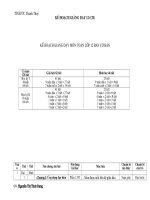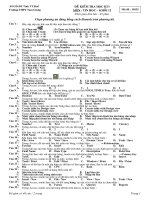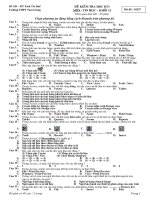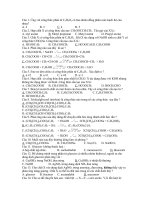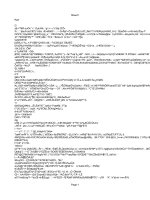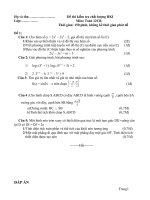Reading skill 12 cơ bản
Bạn đang xem bản rút gọn của tài liệu. Xem và tải ngay bản đầy đủ của tài liệu tại đây (172.68 KB, 17 trang )
G12-UNIT 1-HOME LIFE
Part A-reading
I come from a family of five people: my parents, my two younger brothers and I. My mother works as
(.................................) a nurse in a big hospital. She has to work long hours and once a week she has to work on a night
shift(.................................). My father is a biologist [bai'ɒlәdʒist] (.................................). He works from 8 a.m. to 5 p.m. in
a lab(.................................), but sometimes when there is a project(.................................), he doesn’t come home
until(.................................) very late at night. Although my parents are very busy at work, they try to spend as much time
with their children as possible(.................................). It is generally /'ʤenәrәli/ (.................................) believed that “men
build the house and women make it home” (..........................................................................), but in my family, both
parents join hands(.................................) to give us a nice house and a happy home.
My mother is a very caring (.................................)woman. She takes the responsibility for /ris,pɔnsә'biliti/
(.................................) running the household. She is always the first one to get up in the morning to make sure
(.................................)that we leave home for school having eaten breakfast and dressed in suitable clothes. In the afternoon,
after hospital, she rushes to /rʌʃ/ (.................................) the market, then hurries(.................................) home so that dinner
is ready on the table by the time Dad gets home. Dad is always willing to (.................................)give a hand
with(.................................) cleaning the house. Unlike most men, he enjoys cooking. Sometimes, at weekends, he cooks us
some special dishes. His eel soup /i:l/ (.................................)is the best soup I have ever eaten.
I am now in my final year at the secondary school, and in my attempt to /ә'tempt/ (.................................)win a place at
university, I am under a lot of study pressure /'preʃә/ (.................................). However, being the eldest child and the only
daughter in the family I try to help with(.................................) the household chores /tʃɔ:/ (.................................). My main
responsibility is to wash the dishes and take out the garbage /'gɑ:biʤ/(.................................). I also look after the boys,
who are quite active (.................................) and mischievous /'mistʃivәs/ (.................................)sometimes, but most of the
time they are obedient /ә'bi:djәnt/(.................................) and hard – working. They love joining my father in mending things
around the house at weekends.
We are a very close-knit /nit/ (.................................) family and very supportive /sә'pɔ:tiv/ (.................................) of one
another. We often share our feelings, and whenever problems come up, we discuss them frankly /’fræɳkli/
(.................................)and find solutions quickly. We always feel safe and secure in our family. It is a base from which we
can go into the world with confidence /'kɔnfidәns/ (.................................).
2-CULTURAL DIVERSITY
Traditionally, Americans and Asians have very different ideas about love and marriage /'mæriʤ/ (..........................).
Americans believe in “romantic” marriage – a boy and a girl are attracted to /ә'trækt/ (..........................) each other, fall in
love(..........................), and decide to (..........................)marry /'mæri/ (..........................) each other. Asians, on the other
hand(..........................), believe in “contractual” /kәn'træktʃuәl/ (..........................) marriage – the parents of the bride
/braid/ (..........................) and the groom /grum/ (..........................) decide on the marriage; and love – if it ever develops – is
supposed /sә'pouzd/ to follow (..........................)marriage, not precede /pri:'si:d/ (..........................)it.
To show the differences, a survey /'sә:vei/ (..........................) was conducted /kənˈdʌkt / (..........................) among
American, Chinese and Indian students to determine /di'tә:min/ (..........................) their attitudes /'ætitju:d/
toward(..........................) love and marriage. Below is a summary(..........................) of each group’s responses /ris'pɔns/ to
the four key values /'vælju:/.
Physical attractiveness /ә'træktivnis/ (..........................): The Americans are much more concerned(..........................) than
the Indians and the Chinese with physical attractiveness when choosing a wife or a husband. They also agree that a wife
should maintain /mein'tein/ (..........................) her beauty(..........................) and appearance(..........................) after
marriage.
Confiding /kәn'faidiɳ/ (..........................): Few Asian students agree with (..........................)the American students’
view(..........................) that wives and husbands share /ʃeә/ (..........................) all thoughts(..........................). In
fact(..........................), a majority /mә'ʤɔriti/ (..........................) of Indians and Chinese think it is better and wiser/waiz/ for
a couple not to share certain thoughts. A large number of (..........................)Indian men agree that it is
unwise(..........................) to confide in (..........................)their wives.
Partnership of equals /'i:kwәl/: (..........................) the majority of Asian students reject /'ri:ʤekt/ (..........................)the
American view that marriage is a partnership of equals. Many Indian students agree that a woman has to
sacrifice /'sækrifais/ (..........................) more in a marriage than a man.
Trust built on love: Significantly(..........................), more Asian students than American students agree that a husband is
obliged /ə'blaiʤd/ to(..........................) tell his wife where he has been if he comes home late. The Asian wife can
demand/di'mɑ:nd/ (..........................) a record /'rekɔ:d/ (..........................)of her husband’s activities /æk'tiviti/
(..........................). The American wife, however, trusts /trʌst/ her husband to do the right thing because he loves her not
because he has to.
The comparison /kәm'pærisn/ (..........................)of the four values(..................) suggests that young Asians are not as
romantic as their American counterparts /'kauntәpɑ:t/ (..........................).
Thanh Loan : 36756309
G12 – Unit 3 – Ways of socialising
To attract /ə'trækt/ someone’s attention /ə'tenʃn/ (..........................) so that we might speak to that person, we can use either
verbal /'və:bəl/(..........................) or non-verbal (..........................) forms of communication /kə,mju:ni'keiʃn/
(..........................)Let us look at non-verbal communication in English. Probably the most common /'kɔmən/
(..........................)way of attracting someone’s attention is by waving /weiv/(..........................). For example, if we are at a
noisy party and see a friend come in the door about 20 metres away, we might raise our hand /reiz/ (..........................) and
wave to her as a signal that we see her.
But how hard can we wave in a situation like this? Suppose /sə'pouz/ (..........................) you are at the airport, and you see
your brother get off (..........................)the plane and begin walking toward you. If you are excited, you might jump up and
down and wave as hard as you can to attract his attention. This is the instance /'instəns/ (..........................) where big,
obvious /'ɔbviəs/ non-verbal signals are appropriate. /ə'proupriət/(..........................)
There are, however, some social /'souʃəl/(..........................)situations /,sitʃu'eiʃn/(..........................) where smaller non-verbal
signals /'signl/ (..........................)are more appropriate. In a restaurant, for example, if we want to attract the attention of our
waiter, we have several choices./ tʃɔis/ (..........................)We can wait until he passes near us, catch his eye, and nod /nɔd/
(..........................) slightly to let him know we would like him to come to our table. Or we can raise our hand slightly to
show that we need assistance /ə'sistəns/(..........................) We do not whistle /'wisl/ (..........................)or clap /klæp/
(..........................) our hands to get the person’ attention. That is considered impolite /,impə'lait/(..........................) and even
rude /ru:d/.(..........................)
In most social situations where some informality /,infɔ:'mæləti/(..........................) is allowed, a brief /bri:f/
(..........................) raise of the hand and a small wave is fine. For instance, if you are walking across the schoolyard and see
your teacher approaching /ə'proutʃ/(..........................) you, a small friendly wave to attract his or her attention is
appropriate.
Once you’ve got your friend’s attention, you shouldn’t point at (..........................)the person or thing you want her to look
at. A slight nod will do. Pointing at someone is usually considered rude. Of course, there are times when pointing is
perfectly acceptable /ək'septəbl/ (..........................), such as when a teacher wants to get someone’s attention in class. The
teacher often points to (..........................)the student and says, “David, would you read the next sentences, please?” Pointing
here is not impolite; it’s simply a way to get someone’s attention.
G12 – Unit 4 – School education system
Schooling is compulsory /kəm'pʌlsəri/(..........................) for all English children from the age of 5 to 16. The academic
/,ækə'demik/(..........................) year in England runs from September to July and is divided into /di'vaid/(..........................) 3
terms. Autumn Term is from the beginning of September to mid-December. Spring Term is from the beginning of January
to mid-March and Summer Term from early April to mid-July. Each term is separated by (..........................)a one-week
break called half term, usually at the end of October, mid-February and the end of May.
There are two parallel /'pærəlel/(..........................) school systems in England. The first is the state school system, which is
free for all students and paid for (..........................)by the state. The second category /'kætigəri/ (..........................)is the
“independent” or “public” school system, which is fee-paying. The state school system, which educates 93% of the pupils in
England, can be divided into two levels of education: primary education and secondary education.
See the Table below for more information about the school education system in England.
The National Curriculum /kə'rikjuləm/(..........................) is set by the government and must be followed in all state schools.
It is made up(..........................) of the following subjects: English, Design & Technology, Geography, Maths, Information
Technology, Music, Science, Arts, Physical Education, History, and a Modern Foreign Language. English, Maths and
Science are core /kɔ:/ (..........................) subjects, which are compulsory in the national examinations at certain stages
/steiʤ/(..........................) of the school education system.
School education system in England
Level of educatioin
Pre-school
Primary education
Secondary education
Grade/Year (from – to)
Childcare environment
In an Infant or Primary
school
1–3
4–6
7-9
10 – 11
Age (from – to)
3–4
4–5
5–7
8 – 10
11 - 14
General Certificate of
14 – 16 (end of
Secondary
Education
compulsory education)
(GCSE)
G12 – Unit 5 – Higher education
Three students talk about their first impression of university life.
Sarah
On the first weekend I went out with my new friends, walking around campus /'kæmpəs/(..........................). It was exciting,
thinking how I was at college, meeting people who could become good friends of mine. The most exciting thing was that I
didn’t have to explain to my parents where I was going, who with, or what time I’d be home!
On Saturday night, I followed my roommate /'rummeit/(..........................) t1o a party. The people at the party were busy
playing some game, and no one seemed to notice my existence. I suddenly felt so lonely. Fighting back tears, I ran back to
my room, thinking I would never feel at home at college.
Ellen
My roommate left the window open all the time, even when it was 10 degrees Celsius out, and went to bed at 10 every
night. When she got sick after midterms, she blamed my typing and having a light on while she was trying to sleep.
At first, college was a little daunting /dɔ:nt./ (..........................) I graduated from /'græʤuət/(..........................) a small
school. After seeing the same people over and over for many years, it was amazing, but a little scary /'skeəri/, to be in a
place where it seemed like I never saw the same person twice.
Brenden
The first year at college was probably the best and most challenging year of my life. Academically, I enjoyed it thoroughly.
/'θʌrəli/(..........................) Taking part in the Advanced Engineering project (.........................................................) gave me
a chance to use my creativity /,kri:ei'tivəti/(..........................) and knowledge to help society.
Socially, I made lots of new friends both through engineering and living at St John’s College on campus(..........................).
The social calendar of the colleges provides plenty of opportunities to meet non-engineering students as well as other
engineers, many of whom have become my best mates(..........................).
G12 – Unit 6 – Future jobs
Preparing for a job interview can be stressful(..........................)., particularly when you are called for(..........................).
the first interview. Below are some pieces of advice (..........................).that can help you reduce the feeling of pressure and
create a good impression on(..........................). your interview.
Before the interview
You should find out(..........................)as much as possible about the job and the vacancy(..........................). Before the
interview, you have to send a letter of application(..........................)and your resumes /ri'zju:m/ (..........................) to the
company to express your interest(..........................) in the job and to show that you might be the most suitable
candidate(..........................). for the position.
When you come to the interview, remember to bring with you your school certificates(..........................) and letters of
recommendation /,rekəmen'deiʃn/ (..........................) from your teachers or your previous employers(..........................). In
addition, (..........................) you may jot down(..........................) your qualifications(..........................) and experience that
can relate to the job and prepare for the questions that are often asked during the interview.
Make sure you know where the interview is and how to get there. Be on time or a few minutes early. Don’t forget to dress
neatly and formally.
During the interview
You should concentrate on/'kɔnsentreit/(..........................) what interviewer is saying and make a real effort
to(..........................) answer all the questions the interviewer asks. Be clear, polite and honest. If you do not know something
about the more technical aspects(..........................) of the job, admit it and stress that you are willing to learn. Show
enthusiasm /in'θju:ziæzm/ (..........................) when the job is explained to you. Always show your best side, your keenness
(..........................)to work and your sense of responsibility /ris,pɔnsə'biliti/ (..........................).
Don’t forget to say goodbye to (..........................)the interviewer before leaving the office.
After the interview
If you are offered the position(..........................), congratulations! If you do not get the job, try not to be too
disappointed(..........................). Think about the interviewer’s comments(..........................) because they may help you
prepare better when you are called for the next job interview. Good luck!
G12 – Unit 7 – Economic reforms
One of the most important measures /'meʤə/ to be taken(..........................) to promote the development of a country is to
constantly carry out(..........................) economic reforms. Being aware of this, in December 1986, at its Sixth National
Congress /'kɔɳgres/(..........................), the Vietnamese Communist Party initiated /i'niʃieit/ (..........................)an overall
(..........................)economic reform, commonly known as “Doi Moi” (Renovation). The aim of Doi Moi was to
restructure(..........................) the economy of Vietnam and to raise the living standards(..........................) of the people.
Before Doi Moi our country experienced a lot of difficulties(..........................): the economy was under-developed
(..........................)and was dominated /'dɔmineit/(..........................) by traditional agriculture; the country was poor, the
people led a poor life, production was stagnant /'stægnənt/(..........................); there was a shortage of(..........................)
schools and hospitals, and inflation /in'fleiʃn/(..........................) could be seen in every sector of the economy. To solve
these problems, our Government introduced a number of renovation /renou'veiʃn/(..........................) measures: they
eliminated /i'limineit/(..........................) government subsidies /'sʌbsidi/(..........................); they shifted economic priority
from the heavy industry to three major economic programmes, namely, production of food, production of consumer goods
and production of exports; they reduced state intervention /intə'venʃn/(..........................) in business; they opened trade
relations with all countries in the world and encouraged foreign and domestic private investment.
The subsequent /'sʌbsikwənt/(..........................) National Congresses of the Vietnamese Communist Party held in 1991,
1996 and 2001 continued to reaffirm (..........................)its commitment /kə'mitmənt/(..........................) to Doi Moi, and
called for more administrative /əd'ministrətiv/ and economic reforms. Under the Party’s guidelines(..........................), the
Government adopted (..........................)the Land Law in 1993 and the Enterprises Law in 2000. These have laid legal
grounds(..........................) for dissolving /di'zɔlv/ (..........................)inefficient co-operatives(..........................), expanding
more opportunities for farmers, and encouraging both domestic and foreign private investment.
Since Doi Moi, our country has undergone substantial /səb'stænʃəl/(..........................) changes: productivity and agricultural
exports have constantly increased, the farmers have enjoyed land use rights and have hat greater choice on how to use their
agricultural land , the workers have worked harder as their time is their money, and the children, particularly those from
ethnic /'eθnik/ minorities (..........................)have had more opportunities to enjoy education and training.
We believe that with the strong commitment of (..........................)our Party and Government to Doi Moi, we will gain
greater achievements and build a better life for our people.
G12 – Unit 8 – Life in the future
What will life be like in the future? Different people have different answers to this question; some are
pessimistic(..........................) while others optimistic. (..........................)
Things will be much worse than they are nowadays, pessimists(..........................) say. The whole world will experience a
period of economic depression /di'preʃn/ (..........................). Many large corporations(..........................) will be wiped
out(..........................) and millions of jobs will be lost. The security of the earth will be threatened by
terrorism(..........................) as terrorist(..........................) groups will become more powerful and more dangerous. On the
contrary(..........................), optimists believe that life will be far better than it is today. We will be living in a much cleaner
environment, breathing fresher air and eating healthier foods. We will also be better looked after by a more modern medical
system(..........................). Domestic chores will no longer be a burden/'bə:dn/ (..........................)thanks to the inventions of
labour-saving devices(..........................).
For better or worse(..........................), it is certain that in the future some things will be very different. Developments in
micro technology – computers and telecommunication are bound to(..........................) have a huge influence on
(..........................)various aspects of our lives. Take work, for instance. Robots will do most of the work in factories, so they
will be cleaner places for fewer people to work in them. Offices, too, will go electronic with the result that paper will almost
completely disappear. More people will work from home on computers linked to(..........................) a head office. As for
travel, it is likely that space-shuttle(..........................) technology will be used in normal air travel achieving speeds of up to
15000 kph. Cars will still be with us, but, instead of petrol, they will run on (..........................)anything from electricity to
methane /'meθein/
(..........................) gas. They will also be fitted with (..........................)computers to tell us how efficiently we are driving
and if there is anything wrong on the road ahead.
Whatever we expect from the future, remember that progress has never moved in straight lines, and history is full of
unexpected developments. However, we are confident that the future is in our hands, and it is our responsibility to
contribute to bettering (..........................)our own lives.
G12 – Unit 9 – Deserts
Three great stretches /stretʃ/ (..........................) of sandy desert /'dezət/ (..........................) almost circle /'sə:kl/
(..........................) the centre of Australia. To the north of Nullabor Plain stretches the Great Victoria Desert. In the west, the
Gibbon, Great Sandy and Tanami Deserts comprise /kəm'praiz/ (..........................) an enormous (..........................)sandy
area. North of Lake Eyre lies the Simpson Desert, the last part of Australia to be explored(..........................).
The Simpson Desert lies between Lake Eyre in the south, the Macdonnel Ranges in the north, the Mulligan and the
Diamantina Rivers in the east, and the Macumba and Finke Rivers in the west. The first European entered the Simpson
Desert in 1845. But the desert remained a mystery /'mistəri/ (..........................) until Madigan made an aerial /'eəriəl/
survey (..........................)in 1929. He named the desert after Simpson, President of the South Australian Branch of the
Royal Geographical /ʤiə'græfikəl/ Society /sə'saiəti/ of Australia. (..................................................................)
In 1936, Colson and an Australian Aborigine took camels /'kæməl/ across(..........................) the desert. They traveled along
the border of the South Australia and the Northern Territory. Three years later Madigan led a scientific expedition
/,ekspə'diʃn/(..........................) across the sand dunes /dju:n/ /du:n/ (..........................) on a more northerly route. Colson and
Madigan both traveled eastward across the Simpson Desert.
In the Simpson Desert there are different types of dunes. In the western part of the desert, there is a network of short dunes,
mostly less than 10 metres high. Hummock /'hʌmək/ grasses(..........................) grow in loose sand on the
crest(..........................) and spinifex (..........................)grows in the corridors (..........................)between dunes and on the
more stable slopes.
In the northern part of the desert, the dunes are paralled(..........................) and separated by corridors of low, open
shrubland /ʃrʌblænd/ (..........................). Spinifex grows on the slopes of the dunes. These dunes are deep red-brown, but
the sand is pale /peil/ (..........................)in the area where Queensland, South Australia and Northern Territory meet. Dry salt
lakes up to 70 kilometres long and 15 kilometres wide lie between long dunes with crests 20 metres high.
G12 – Unit 10 – Endangered species
Endangered species /'spi:ʃi:z/ (..........................) are plant and animal species which are in danger of
extinction(..........................). Over 8300 plant species and 7200 animal species around the globe(..........................) are
threatened(..........................) with extinction, and many thousands more become extinct each year before biologists can
identify(..........................) them.
The primary causes(..........................) of species extinction are habitat destruction(..........................), commercial
exploitation /,eksplɔi'teiʃn/ (..........................) and pollution. The drainage(..........................) of wetlands, cutting of forests,
urbanization(..........................) and road and dam(..........................) construction(..........................) have destroyed or
seriously damaged natural habitats. Since the 1600s, worldwide commercial exploitation of animals for food and other
products has seriously reduced the number of rare species. Toxic(..........................) chemicals in the air and land,
contaminated(..........................) water and increased water temperatures have also driven many species to the verge
(..........................)of extinction.
Plant and animal extinction leads to(..........................) a loss(..........................) of biodiversity(..........................).
Maintaining(..........................) biodiversity is important for us in many ways. For example, humans depend on species
diversity(..........................) to have food, clean air and water, and fertile /'fə:tail/ (..........................) soil for agriculture. In
addition, we benefit(..........................) greatly from the many medicines and other products that biodiversity provides.
Different conservation efforts have been made in order to save endangered species. The Red List – a global
list(..........................) of endangered and vulnerable /'vʌlnərəbl/ (..........................) animal species – has been introduced to
raise people’s awareness of(..........................) conservation needs. Governments have enacted laws(..........................) to
protect (..........................)wildlife from commercial trade and overhunting. A number of wildlife habitat reserves /ri'zə:v/
(..........................) have been established so that a wide range of(..........................) endangered species can have a chance to
survive and develop.
G12 – Unit 11 – Books
On the subject of reading, Francis Bacon, who lived at about the same time as Shakespeare, wrote these words, “Some
books are to be tasted(..........................), others to be swallowed/ 'swɔlou/ (..........................), and some few to be
chewed(..........................) and digested(..........................)”. This good advice shows how it is possible to read different types
of books in different ways. For example, you might pick up a travel book (..........................)and read a few pages before
going to sleep. It is enough to dip into it(..........................) and read bits here and there. In a word, this is “tasting”.
Some stories are for “swallowing”. Imagine /i'mæʤin/ (..........................) that you have found a good story, and, what is
even more important, the time to enjoy it. You might be on holiday, or on a long train journey. If it is a good book, you
might say, “It’s so good I can’t put it down (..........................)” But not all stories belong to this class. Reviewers
sometimes describe(..........................) books as “hard-to-put-down”, or “hard-to-pick-up-again”.
Other books are for reading slowly and carefully. If it is a book on a subject (..........................)that you are interested in ,
you will want to “chew /tʃu:/ (..........................) and digest /'daiʤest / (..........................) it”. That does not mean reading it
too slowly. When you pick up a book for the first time, check that it is not too difficult. Do not start a book unless you can
see from the first few pages that it is on you can easily read and understand.
Some people think that as more and more people have television in their homes, fewer and fewer people will buy books to
read. Why read when television can bring you all the information and stories with colour, picture and action? But, in fact,
television has not killed reading. Today, more books of every kind are sold than ever before. Books are still a cheap way to
get information and entertainment, and you can keep a book forever and read it many times. Books in the home are a
wonderful source of knowledge /'nɔlidʤ/ (..........................)and pleasure /'pleʤə/ (..........................).
G12 – Unit 12 – Water sports
Water polo /'poulou/(..........................)is played in a pool 1.8 metres deep, 30 metres long and 20 metres wide, with a goal 3
metres high and at least (..........................)0.9 metre above the water. The goal is marked(..........................) by
vertical /'və:tikəl/ posts(..........................), a crossbar and a net.
There are seven players per team, six swimmers and a goalie /'gouli:/ (..........................). The home team wears white
caps(..........................), the visiting team blue ones and the goalies wear red caps with the number 1 in white.
Like football, the game begins with the ball in the centre of the pool and both teams sprint /sprint/ for(..........................) it
from their own goal lines. The ball can be advanced by passing with one hand or swimming with the head above the water
and the ball between the arms so it rides on the wave(..........................) created by the swimmer’s head. No player except
the goalie can hold the ball with both hands(..........................).
Defensive /di'fensiv/ players(..........................) are not allowed to interfere /,intə'fiə/ (..........................) with the opponent’s
/ə'pounənt/(..........................) movements unless the player is holding the ball. Major fouls are penalized /'pi:nəlaiz/
(..........................) by one minute in the penalty box and a player is ejected /'i:ʤekt/ (..........................) after
committing/kə'mit/ (..........................)five personal fouls / faʊl / (..........................).
For minor /'mainə/(..........................) fouls, such as holding or punching /pʌntʃ/ (..........................) the ball, a free throw is
awarded /ə'wɔ:d/ from(..........................) the spot(..........................) of the foul. At least two players must touch /tʌtʃ/
(..........................) the ball after a free throw before a goal can be scored.
A game is divided into(..........................) quarters /'kwɔ:tə/ (..........................) ranging /reindʤ/ from(..........................)
five to eight minutes in length /leɳθ/ (..........................). After a tie, there are two overtime periods of three minutes each. If
the game is still tied after overtime periods, two teams continue to play 3-minute overtime until the referee’s decision is
made. (........................................)
G12 – Unit 13 – The 22nd SEA Games
The 22nd Southeast Asian Games(...........................) were held in Vietnam from the 5th to 13th December, 2003. Although it
was the first time Vietnam hosted /houst/ (...............) such a big sports event, the Games were a great success. The Games
really became a festival that impressed(...........................) sports enthusiasts(...........................) with its spirit:
solidarity/,sɔli'dæriti/ (...........................), co-operation(...........................) for peace /pi:s/ (...........................) and
development.
Athletes from 11 participating countries(...........................) competed in 32 sports, and 444 gold medals /'medl/
(...........................) were won. Some teams such as table tennis, badminton(...........................), karatedo(...........................),
volleyball, basketball and wrestling /'resliɳ/ were composed of top competitors in the region. Many Games
records(...........................) were close to (...........................)international levels. Vietnam won 158 gold medals to finish at
the top of the Southeast Asian Games medal standings. Thailand was ranked second with 90 golds, and Indonesia was third
with only 55 golds. Singapore and Vietnam were the two nations which had participants who were presented /pri'zent/
(...........................) with the Most Outstanding Athlete titles /'taitl/ (...........................) in the Swimming and Shooting events.
The Vietnamese Women’s Football team successfully defended the SEA Games title. The Men’s Football team won a silver
medal. In other sports such as karatedo, athletics /æθ'letiks/ (...........................), bodybuilding and wushu(...........................),
the young and energetic /,enə'ʤetik/ (...........................)Vietnamese athletes performed excellently /'eksələntli/
(...........................) and won a lot of gold medals.
Vietnam’s first place finish was not surprising. Firstly, to prepare for the 22 nd SEA Games, Vietnam carried
out(...........................) an intensive /in'tensiv/ (...........................) programme for its athletes, which included training in
facilities /fə'siliti/ (...........................), both home and abroad /ə'brɔ:d/ (...........................). Secondly, with the strong support
of their countrymen, the Vietnamese athletes /'æθli:t/ (...........................) competed in high spirits(...........................). The
country’s success has proved(...........................) that Vietnam can organize sporting events /i'vent/ on (...........................)an
international level. A plan has been proposed for(...........................) Vietnam to host the Asia Sports Games at some point
(...........................)in the future.
G12 – Unit 14 – International organizations
The Red Cross is an international humanitarian /hju:,mæni'teəriən/ (...........................) agency. In times of
war(...........................), it is dedicated /'dedikeit/ to reducing (...........................)the sufferings /'sʌfəriɳ/ (...........................)
of wounded soldiers /'soulʤə/ (...........................), civilians /'siviljən/ (...........................), and prisoners of war. In time of
peace(...........................), it gives medical aid and other help to victims of major disasters /di'zɑ:stə/ (...........................) such
as floods(...........................), earthquakes, epidemics /,epi'demik/ (...........................), and famines /'fæmin/
(...........................).
The initiative /i'niʃiətiv/ (...........................) for founding the Red Cross came from a Swiss man called Jean Henri Dunant.
Appalled(...........................) by the almost complete lack of care for wounded soldiers, he appealed to
(...........................)the leaders of nations to found societies devoted /di'voutid/ to(...........................) the aid of the wounded
in wartime. A conference /'kɔnfərəns/ (...........................)was held in Geneva in 1864, and official
delegates(...........................) of 12 nations signed the first Geneva Convention /kən'venʃn/, laying down
(...........................)rules for the treatment and protection of the wounded and the disaster-stricken(...........................). It was
also at this meeting that the famous symbol of the organization, the white flag bearing a red cross, was adopted.
(...........................)
It was Henry Davison, president of the American Red Cross War Committee, who proposed(...........................) forming a
federation (...........................)of these National Societies. An international medical conference initiated by Davison resulted
in(...........................) the birth of the League of Red Cross Societies(...........................) in 1991. In November 1991, it
became the International Federation of Red Cross(...........................). The Federation’s mission is to improve the lives of
vulnerable
people
who
are
victims
of
natural
disasters,
poverty(...........................)
and
health
emergencies(...........................).
The International Red Cross has its headquarters (...........................)in Geneva, Switzerland. Today, the total number of
national Red Cross societies from all over the world has mounted to(...........................) 186. So help and support are able to
be rapidly sent to wherever there are victims of catastrophe /kə'tæstrəfi/ (...........................), for example, to help the victims
of Asia tsunami (...........................)in 2004. Red Cross and Red Crescent National Societies (...........................)in the
countries hit by the tsunami reacted without hesitation (...........................)to help those struggling to survive, despite the fact
that many staff and volunteers had lost families, friends, colleagues /kɔ'li:g/ (...........................) and
livelihoods(...........................). For example, the Indonesian Red Cross Headquarters in Banda Aceh was washed away, but a
temporary /'tempərəri/ (...........................)office was in place within hours and the injured were being helped.
G12 – Unit 15 – Women in society
Throughout much of the history of human civilization /,sivilai'zeiʃn/(...........................), deep-seated cultural beliefs
(...........................)allowed women only limited roles(...........................) in society. Many people believed that women’s
natural roles were as mothers and wives. These people considered women to be better suited for childbearing /'tʃaild,beəriɳ/
(...........................) and homemaking /'houm,meikiɳ/ (...........................)rather than for involvement in the public life of
business or politics. Widespread /'waidspred/ doubt /daut/ (...........................) about women’s intellectual ability led most
societies to deny /di'nai/(...........................)education, employment and many legal and political rights to women. It was men
who controlled most positions /pə'ziʃn/ (...........................)of employment and power /'pauə/ (...........................) in society.
The struggle /'strʌgl/ for(...........................) women’s rights – the rights(...........................) that establish the same social,
economic, and political /pə'litikə/ status /'steitəs/ (...........................) for women as for men – began in the 18th century
during a period known as the Age of Enlightenment /in'laitnmənt/ (...........................). During this period, political
philosophers /fi'lɔsəfə/ (...........................) in Europe began to argue /'ɑ:gju:/ (...........................) that all individuals
/,indi'vidjuəl/ (...........................), male or female, were born with natural rights that made them free and equal. These
pioneer thinkers advocated /'ædvəkət/ (...........................)that women should not be discriminated /dis'krimineit/
(...........................)against on the basis /'beisis/ of their sex /seks/. (...........................)
Today, although their status varies in different countries, women in most parts of the world have gained significant
legal /'li:gəl/ rights(...........................). The most important of these are: the right to have equal work opportunities and pay
to men, the right to vote /vout/ and the right to formal education(...........................).
G12 – Unit 16 – The Association of Southeast Asian Nations
The Association /ə,sousi'eiʃn/ of Southeast Asian Nations(.................................................), or ASEAN, was
founded(...........................) on 8th August, 1967, in Bangkok, Thailand by the five original /ə'ridʤənl/
(...........................) member countries, namely(...........................), Indonesia, Malaysia, the Philippines, Singapore and
Thailand. Brunei joined ASEAN in 1984. Vietnam became its seventh member in 1995. Laos and Myanmar were admitted
to(...........................) this association(...........................) in 1997, and Cambodia in 1999. The main goals(...........................)
of the Association are to accelerate/æk'seləreit/ (...........................) economic growth, social progress(...........................) and
cultural development; and to promote peace and stability(...........................) through respect for justice(...........................),
and the rule of law(...........................), in the relationship between countries in the region.
ASEAN has a population of(...........................) 575.5 million, accounting for(...........................) about 8.7% of the world’s
population. Its total area is 4,464,322 square kilometers. It is a region of diverse cultures, and people in some countries such
as the Philippines, Brunei, Malaysia and Singapore speak English besides their own languages. According to the statistics
/stə'tistiks/ recorded(...........................) in 2007, ASEAN had a combined gross domestic /də'mestik/ product
(...........................)of about US$ 1282 billion. This combined GDP grew at an average(...........................) rate of around 6%
per year from 2003 to 2007. The economies of the member countries are diverse(...........................), although its major
products include electronic /ilek'trɔnik/ goods(...........................), oil and wood. The Governments of ASEAN countries
have paid special attention to (...........................)trade. In 2006, the ASEAN region had a total trade of US$ 1405 billion. It
has been estimated that a free trade area would be established in the region by 2020. The ASEAN leaders have also adopted
the ASEAN Vision 2020, which is aimed at(...........................) forging /fɔ:ʤ/ (...........................) closer economic
integration(...........................) within the region. The Hanoi Plan of Action, adopted in 1998, serves as the first in a series of
planned actions leading up to(...........................) the realization of the ASEAN Vision(...........................).
Today, ASEAN economic cooperation covers many areas(...........................): trade, investment, industry, services, finance,
agriculture, rural development, forestry /'fɔristri/ (...........................), energy, transportation and communication, science and
technology, small and medium enterprises(...........................), and tourism. ASEAN has actively worked to improve the
socio-economic situation and solve problems among its member countries.


